The spontaneous light emission of chemical reactions, or chemiluminesence, is widely employed in optical diagnostics of combustion processes. In hydrocarbon flames, this chemiluminescence is due to the formation and subsequent light emission of excited-state radicals, being CH* and OH* the most prominent. Time-resolved imaging of this chemiluminescence provides information about the structure and dynamics of the combustion process by giving detailed insights into the location of the reaction zone, the heat release rates, and the equivalence ratio [Liu et al.].
In the case of hydrogen combustion, the chemiluminescence of carbon containing radicals is absent. However, the formation of excited OH* radicals still occurs by a collisional process involving third-body recombination [Zhao et al.]:
H + O + M ⇌ OH*+ M
OH* → OH*+ hυ
OH*+M ⇌ OH+ M
The presence of OH* in hydrogen combustion allows the study of these processes using chemiluminescence imaging. Since OH* chemiluminescence has a distinct emission maximum at 308 nm, imaging is performed with instrumentation optimized for capture UV light. The HiCATT (High-speed intensified Camera Attachment) from Lambert Instruments is an intensified camera attachment designed to be used with high-speed and ultra high-speed cameras to image dynamic processes characterized by low-light levels and fast changing conditions. The HiCATT, when equipped with a second generation S20B photocathode, is the ideal instrument to image UV chemiluminescence, having an unmatched peak quantum efficiency of over 30%:
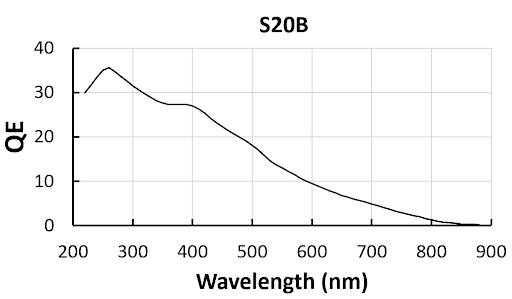
The following imaging example involves a simple atmospheric pressure hydrogen diffusion flame set up on a table top. Although the emission of visible light is lower than in a hydrocarbon flame, direct observation shows tones of violet and blue chemiluminescence due to other recombination reactions [Lee et al.]
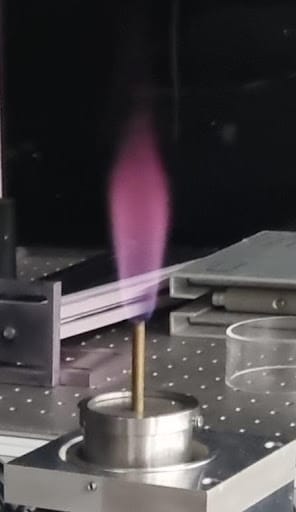
A high-speed camera is still sensitive enough to image the visible light from the flame at several kHz, although the amount of light decreases significantly as the frame rate increases. As shown below, when the light reaching the camera is limited to the chemiluminescence of OH* using a bandpass filter centered around 308 nm, intensified imaging using a HiCATT clearly reveals the flame front at an even higher rate of 5700 fps and an intensifier gate of 40 μs.
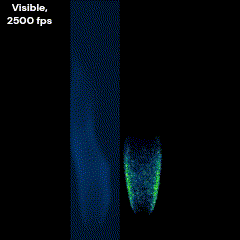
Imaging of OH* chemiluminescence in the same hydrogen flame can easily be performed at hundreds and even thousands of kHz (even reaching ultra high-speed!), with the limiting factor becoming the camera to which HiCATT is attached to. In the following image, reaching 18500 fps was only possible by reducing the camera’s active area and thus only one side of the flame is observed. However, the use of the HiCATT attachment results in a bright and sharply defined flame front.
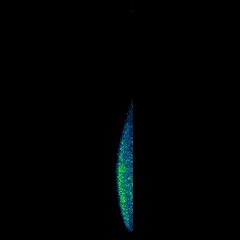
Other applications of the HiCATT camera attachment for hydrogen and hydrogen-enriched combustion imaging:
OH* chemiluminescence imaging in hydrogen diffusion flames:
https://doi.org/10.1016/j.combustflame.2018.08.019
OH* chemiluminescence in hydrogen stratified charge combustion to study the use of hydrogen as a fuel for IC engines:
https://doi.org/10.1016/j.fuel.2021.121045
OH-PLIF imaging in a hydrogen-rich jet injected normal to a turbulent crossflow:
https://doi.org/10.1016/j.combustflame.2014.10.014
Time-resolved chemiluminescence imaging of a hydrogen-enriched stratified swirl flame:
https://doi.org/10.1016/j.proci.2020.06.017
Key advantages of the HiCATT camera attachment for intensified hydrogen combustion imaging:
- S20B photocathode with peak efficiency of 35% for UV applications, ideal for OH* chemiluminescence and OH-PLIF imaging
- Ultra-high speed imaging capability
- Gates as short as 3ns
- Relay lens focusing feature for sharper images with any camera
- User-exchangeable relay lenses for use with multiple cameras
- Easy coupling with a rotating camera holding tube for safe handling
- Programmable gate patterns to accommodate imaging of highly variable light conditions
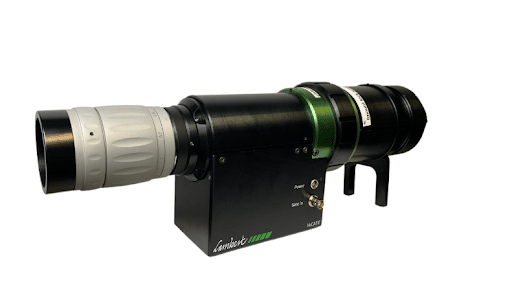
For more information about the HiCATT camera attachment, visit our product page and get in touch with us @ [email protected].
References:
Liu, Y., Tan, J., Wan, M., Zhang, L., and Yao, X., “Quantitative Measurement of OH* and CH* Chemiluminescence in Jet Diffusion Flames,” ACS Omega, 5, 15922-15930 (2020).
Zhao, M., Buttsworth, D., and Choudhury, R., “Experimental and Numerical Study of OH* Chemiluminescence in Hydrogen Diffusion Flames,” Combustion and Flame, 197, 369-377 (2018).
Lee, S., Kim, G., and Bae, C., “Lean Combustion of Stratified Hydrogen in a Constant Volume Chamber,” Fuel, 301, 121045 (2021)
